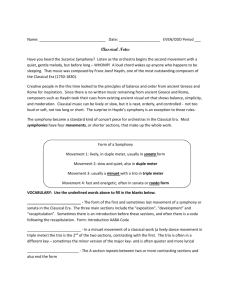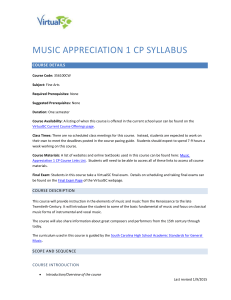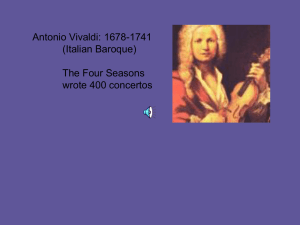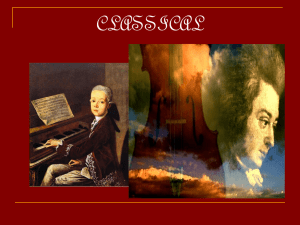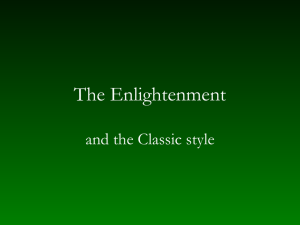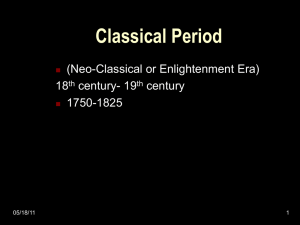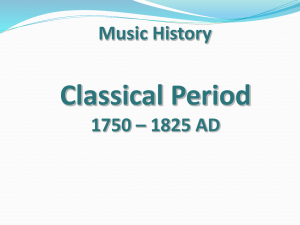Classical Handouts
advertisement
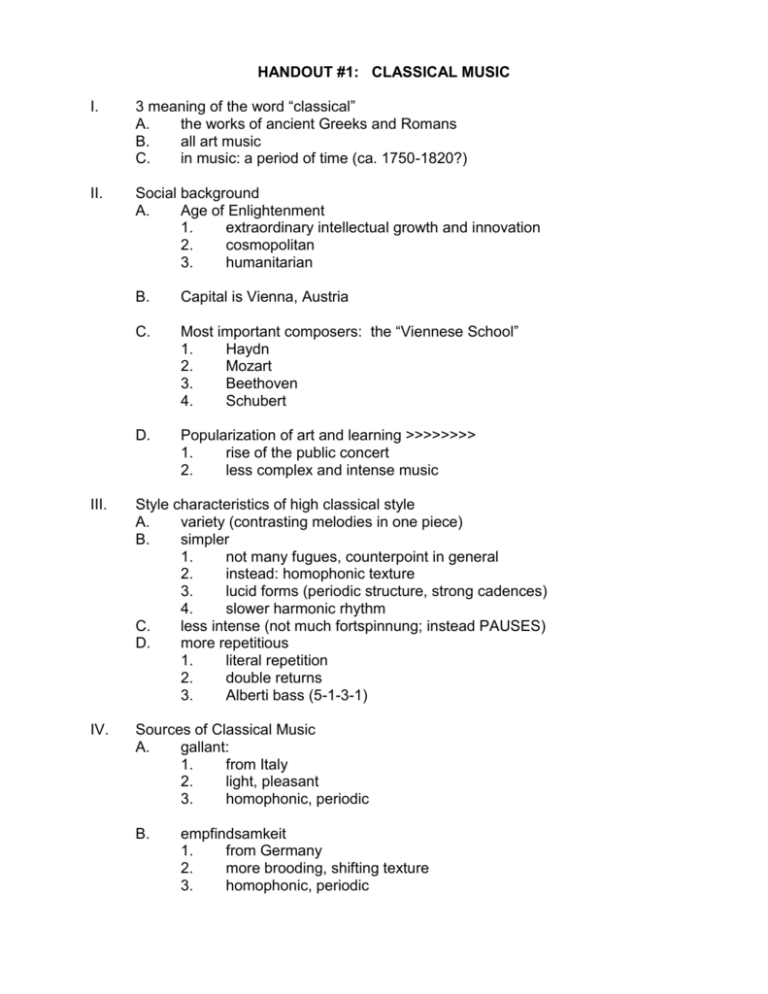
HANDOUT #1: CLASSICAL MUSIC I. 3 meaning of the word “classical” A. the works of ancient Greeks and Romans B. all art music C. in music: a period of time (ca. 1750-1820?) II. Social background A. Age of Enlightenment 1. extraordinary intellectual growth and innovation 2. cosmopolitan 3. humanitarian B. Capital is Vienna, Austria C. Most important composers: the “Viennese School” 1. Haydn 2. Mozart 3. Beethoven 4. Schubert D. Popularization of art and learning >>>>>>>> 1. rise of the public concert 2. less complex and intense music III. Style characteristics of high classical style A. variety (contrasting melodies in one piece) B. simpler 1. not many fugues, counterpoint in general 2. instead: homophonic texture 3. lucid forms (periodic structure, strong cadences) 4. slower harmonic rhythm C. less intense (not much fortspinnung; instead PAUSES) D. more repetitious 1. literal repetition 2. double returns 3. Alberti bass (5-1-3-1) IV. Sources of Classical Music A. gallant: 1. from Italy 2. light, pleasant 3. homophonic, periodic B. empfindsamkeit 1. from Germany 2. more brooding, shifting texture 3. homophonic, periodic V. VI. New Genre in Late Baroque/Early Classical Period: Comic Opera A. Origins: 1. Intermedio: comic scenes between 3 acts of opera seria 2. Intermezzo(i): independent intermedio a. short length b. reduced proportions (few characters, including basso buffo; no accompanied recitative) B. Example: La serva padrona (1733) 1. written by Pergolesi (1710-1736) 2. caused War of the Buffoons (Querelle des Bouffons) 3. originally was intermedio to a serious opera (Il prigionier superbo) 4. short: 7 musical numbers altogether Later Comic Opera A. B. Characteristics 1. full length opera (6 to 9 characters) 2. duets, trios, quartets at ends of acts 3. vivacious, light and natural, 4. major key 5. singers were not virtuosic 6. not cosmopolitan (vernacular language) Types: 1. Italy: Opera Buffa, Dramma Giocoso 2. France: Opéra comique 3. Germany: Singspiel 4. England: Ballad Opera NOTE: all use spoken dialogue instead of recitative (except for Italian comic opera) VII. Example: Ballad Opera A. Most famous: The Beggar’s Opera (1728) 1. it’s a parody: new words to old tunes 2. text is by John Gay; music is arranged by Johann Christoph Pepusch 3. story is a satire of Italian opera HANDOUT #2: CLASSICAL MUSIC Part I: Opera I. II. Opera Seria during the Late Baroque Period A. Librettists: 1. Pietro Metastasio (1698-1782) 2. Apostolo Zeno (1668-1750) B. Musical Characteristics: 1. drama only; no comic elements 2. most have a lieto fine (happy ending) 3. da capo arias dominated (ABA) 4. ensembles are rare 5. instruments are strictly accompanimental C. Libretto Characteristics: 1. 3 acts 2. recitative (usually secco)-aria pairs 3. 6 characters: a. trio I: primo uomo, prima donna and tenor b. trio II: secondo uomo, seconda donna, and ? D. Composers: 1. Handel 2. Alessandro Scarlatti 3. Vivaldi 4. Vinci 5. Leo Opera Reform at the Beginning of the Classical Period: (ca. 1750s) A. Results of opera reform 1. more drama 2. aria not as dominant 3. more accompanied recitative 4. more choruses 5. bigger orchestra 6. variety of aria forms B. Composers: 1. most important is: Gluck (1714-87) 2. Jommelli (1714-74) 3. Traetta (1727-79) C. Operas by Gluck: 1. Orfeo et Euridice (1762) 2. Alceste (1767) 3 librettist was Calzabigi (1714-1795) PART II: Instrumental Music: Sonata and Symphony I. II. Domenico Scarlatti (1685-1757) A. Son of Alessandro B. Known for keyboard sonatas (essercizi) 1. Baroque characteristics a. binary sonata form b. harpsichord 2. Classical characteristics a. several ideas b. strong cadences c. repetition Giovanni Battista Sammartini (1701-75) A. Known for symphonies (stems from italian opera overture (FSF)) B. Baroque characteristics 1. rounded binary form (immediate forerunner of classical sonata form) 2. some motivic development, sequences 3. 1 theme only C. Classical characteristics 1. slower harmonic rhythm 2. clear contrasts of key and texture 3. repetition HANDOUT #3: CLASSICAL MUSIC Instrumental Music Continued: Mannheim and Berlin I. II. Mannheim A. Famous composer: Johann Stamitz (1717-57) B. Why famous: 1. largest in Europe 2. famous mannerisms: a. Mannheim crescendo (a.k.a. Mannheim roll): a crescendo with a measured (chromatic) tremolo in the upper strings b. Mannheim sigh: appoggiatura c. Mannheim steamroller: a rise in pitch is coordinated with an increase in loudness, textural density, and # of instruments d. Mannheim rocket: rapid rising arpeggio 3. varied orchestration 4. larger dimensions 5. 4 movements Berlin A. C.P.E. Bach (1714-88) 1. worked for Frederick the Great in Berlin 2. later worked in Hamburg 3. mainly known for clavier works, but also symphonies, chamber works. B. Other claim to fame: 1. main proponent of Emfindsamkeit a. characteristics: 1) sigh figures 2) short phrases 3) lots of ornaments 4) frequents changes of rhythm 5) chromaticism = jumpy, emotional music Baroque characteristics: 1. continuo 2. figured bass 3. sequences 4. contrapuntal writing 5. no clear-cut second theme C. D. Classical characteristics: 1. serious (like Beethoven) 2. variety of ideas 3. larger proportions HANDOUT #4: CLASSICAL MUSIC HAYDN I. Franz Joseph Haydn (1732-1809) A. Why important? 1. major transitional figure: Baroque Classical 2. known for instrumental music, especially symphonies (over 100) and string quartets (over 80) 3. highly influential to both Mozart and Beethoven 4. solid craftsman B. Biography: 1. born in Rohrau (southeast of Vienna) 2. brother was Micheal 3. started as a singer 4. worked as Kapellmeister for the Esterházys (Anton, Nicholas) between 1761-90 5. summers at Esterháza, winters at Eisenstadt 6. went to London in 179 with Salomon (impresario) 7. died in Vienna C. Output: WOW!!! Some highlights: 1. 12 London Symphonies (date from 1791-95): include • Surprise Symphony • Military Symphony • Drum Roll Symphony • Clock Symphony • Miracle Symphony • London Symphony 2. Gli Scherzi String Quartets, op. 33 3. Oratorios: The Creation (1798) and The Seasons (1801) D. Personality: 1. good sense of humor 2. self-reliant and lonely E. Musical style: 1. an original (e.g., created new genres, experimented with formal structure) 2. sense of humor 3. frequent use of counterpoint 4. energetic (due to dissonances, sequences) 5. monothematic sonata forms 6. symphonies begin with slow intro’s 7. uses sonata cycle: F-S-minuet-F II. III. More on Haydn’s Symphonies: 4 periods A. Early (early-mid 1760s): 1. concertante elements 2. featured aspects of Baroque concerto grosso B. “Sturm und Drang” (1768-74) 1. intense (dark and stormy) 2. minor key Definition of S and D: a movement of German literature in the second half of the 18th century; goal: the powerful, shocking, even violent expression of emotion (e.g., Goethe’s Erlkönig) 3. BUT this term may be incorrect. H’s S & D style may stem from theater rather than literature C. Festive (1774-88) 1. no more minor key 2. trumpets and/or drums D. London Symphonies (1788+) 1. BIG works created for Salomon 2. no more concertante More on Haydn’s String Quartets A. What’s new: balanced texture 1. thematic material is even distributed among the 4 instruments 2. contrasts to hierarchical texture of the string quartet’s ancestor (i.e., the trio sonata) B. Still: there’s a good deal of “old-fashioned” counterpoint HANDOUT #5: CLASSICAL MUSIC SONATA I. Three terms involve the word sonata A. Sonata 1. Literally, a piece to be played on one or more instruments 2. After ca. 1750, an ambitious work in several movements for one or two solo instruments. 3. After ca. 1750, typically for piano B. Sonata Cycle (a.k.a. multi-movement cycle) 1. A three- or four- movement structure in Classical-era instrumental music 2. Each movement is in a prescribed tempo and form 3. Four movement plan: used in symphonies, chamber music, piano sonatas a. F-S-Minuet-Fast(er); or b. F-S-Scherzo-Fast(er) 4. Three-movement plan: used in concertos and Mozart’s piano sonatas a. F-S-F C. II. Sonata Form: Form used mostly in first movements, usually consisting of an exposition, development, and recapitulation More on sonata form: A. classical sonata form has a three-part design B. “textbook” diagram: EXPO. DEVEL. RECAPIT (CODA) Theme 1 2 (rep) 1--? 1 2 Key (M) or (m) i I III V V-- I i I iv-i C. III-- Term to know: sonata principle V V i ? IV-I III. More on sonata cycle: A. Movement 2: design is: 1. ABA’; or 2. theme and variations B. Movement 3: design is a minuet/trio 1. definition: an ABA form in moderate triple meter 2. A = minuet, B = trio, A = minuet 3. graceful 4. originally was dance music (therefore, a lot of repetition) 5. trio usually has a lighter texture than minuet 6. Diagram: or C. A minuet a/ba/(rep) a/b B trio c/dc (rep) c/d A minuet a/ba (no rep) a/b Movement 4: sonata form or rondo 1. more on rondo a. derives from rondeau (a forme fixe) b. first section keeps recurring c. examples: ABABA, ABACA, and ABACABA HANDOUT #6: CLASSICAL MUSIC MOZART I. Biography: Wolfgang Amadeus Mozart (1756-1791) A. From Salzburg B. Renowned child prodigy (“wunderkind”) C. Why successful as a child? 1. father’s excellent teaching; W. learned good working habits and self-discipline 2. broad exposure to different musical styles 3. great aptitude D. Why not successful as an adult? 1. no secure job a. boss from hell: Count Colloredo Hieronymus 2. contradictory and insolent personality 3. fickle Viennese audiences 4. debt E. Output: 600+ works 1. excelled at every genre 2. perhaps most famous for: a. operas: The Marriage of Figaro Cosi fan tutte Don Giovanni Magic Flute Idomeno b. concerti: 17 for piano, 23 altogether F. Style: 1. 2. 3. 4. G. lots of themes (=fertile brain) lucid forms: themes are clear-cut polished and fluid (“music should flow like oil”), yet there’s depth compared to Haydn: • little “fortspinnung” (motivic development) • “pack-your-suitcase” developments (theme travels through new harmonies) • much less development in general • strongly contrasting themes = clear bithematic expositions • more theatrical and dramatic since there are strong contrasts • more passionate? • BOUNCE! Influential figures in Mozart’s life: 1. his father 2. Haydn 3. II. Baron van Swieten Concerto form A. form of first movement: 1. 2. 3. 4. often called double exposition form is literally a combination of full sonata form with orchestral ritornello ritornello: appears at beginning, in the bridge between exposition and development, at end of movement cadenza (short and showy solo) is located between the end of the recapitulation and the beginning of the coda DIAGRAM Expo 1 Expo. 2 Dev. Recap. (cad) Coda O (Rit.) (S+O) (S+O) (S+O) Rit. S (S+O) Rit. B. second movement: variety of forms possible (e.g., ABA, double exposition) C. third movement: sonata-rondo HANDOUT #7: CLASSICAL MUSIC BEETHOVEN I. Biography: Ludwig van Beethoven (1770-1827) A. Born in Bonn B. Learning disabilities C. Moved to Vienna in 1792 D. Main crisis in life: deafness, due to typhus in 1976 1. This crisis is reflected in an unsent letter, “Heiligenstadt Testament” a. half suicide note b. half aesthetic credo II. Influences A. Haydn (Beethoven’s teacher in 1792) B. Bach and Handel 1. from Bach: fugues, contrapuntal textures 2. from Handel: loftiness and choral treatment III. Overall picture A. Angry genius B. Eccentric C. Successful D. Well-loved E. Transitional F. Revolutionary IV. Output: not prolific A. B. C. D. E. F. 9 symphonies, including • Third (“Eroica) • Fifth • Sixth (“Pastoral”) • Seventh • Ninth (“Choral”) 1 opera: Fidelio (has 4 different overtures: Leonore 1, Leonore 2, 3 and 4) 5 piano concertos 16 string quartets 32 piano sonatas 2 Masses (including Missa solemnis) V. Three style periods A. Early (“classic”): 1782 – 1802 1. resembles style of Haydn and Mozart a. Alberti bass b. short length 2. more like Haydn a. slow introduction in First Symphony, op. 21 (1800) b. weak second theme in Sonata in F minor, op. 2, #1 (1795) 3. already different, though a. he add another movement to piano sonatas (4, instead of 3) b. more passionate and intense, e.g., “Pathétique Sonata, Op. 13 (1798-9) B. Middle (“heroic”): 1802 - 1815 1. expansion via many themes, long developments and codas, enlarged instrumentation, more movements, noble 2. greater integration of movements a. SSSL of Fifth Symphony, Op. 67 (1807-8 3. More on Third Symphony (1803) a. originally, “Bonaparte” Symphony, later revised to “Eroica” (Heroic) Symphony b. watershed work: biggest symphony to date C. Late (“integration”): 1815 – 1827 1. not as “heroic”: more introspective, serene 2. abstract (more learned devices such as fugues, strettos, etc.) 3. increased use of variation 4. formal barriers break down (sonata form and variation form mesh for example in the last movement of the Ninth Symphony) 5. complete integration of material (harmonic, motivic, key)
